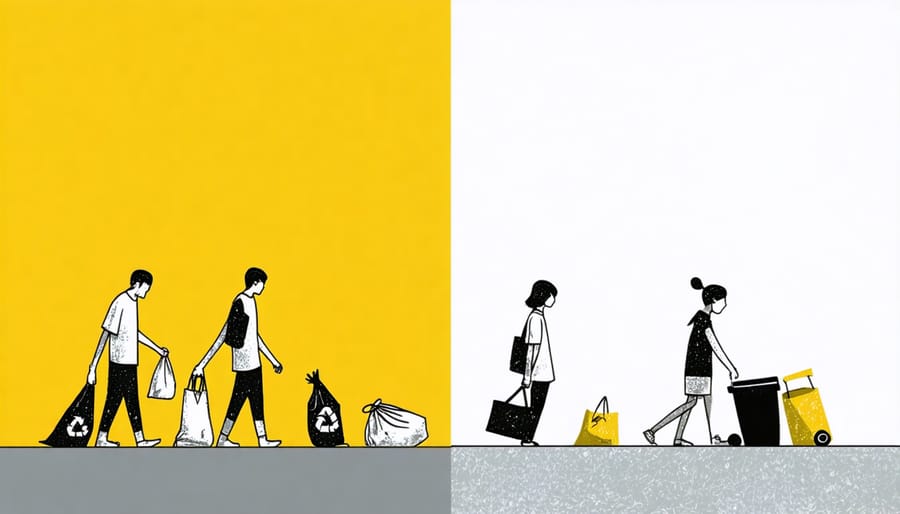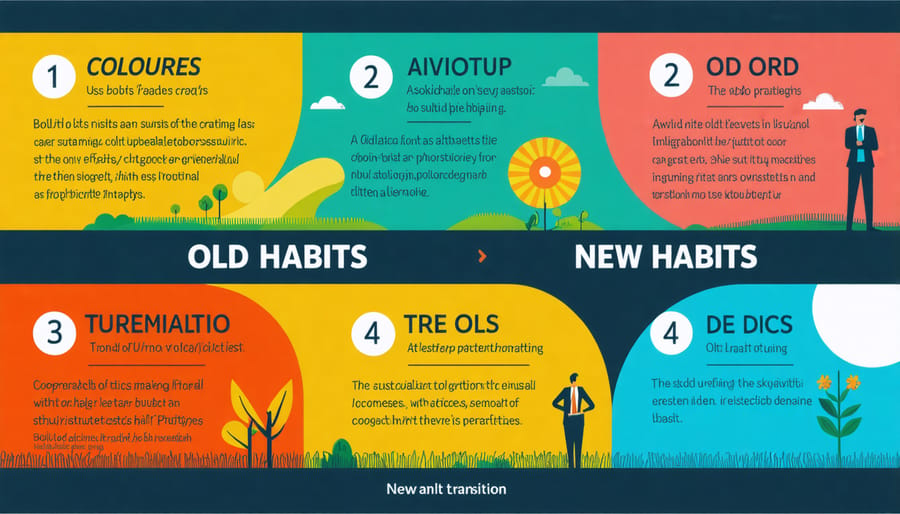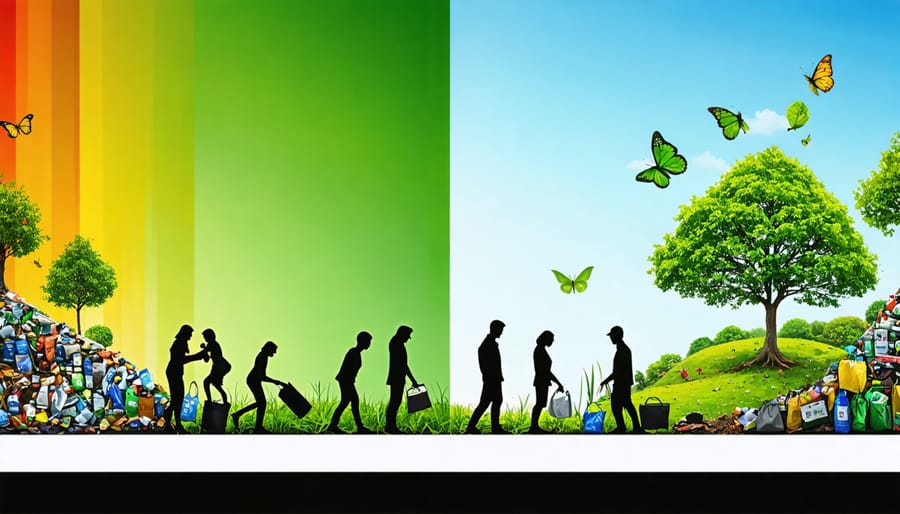Social norms shape our daily behaviors far more powerfully than laws or regulations ever could. In Australia’s push toward sustainable energy practices, understanding these invisible forces has become crucial for environmental change. When 87% of neighbors install solar panels, the remaining households feel a natural pressure to follow suit—not through mandate, but through the subtle psychology of collective behavior.
This powerful intersection of psychology and social behavior offers unprecedented opportunities for advancing sustainability. Research shows that people are twice as likely to adopt eco-friendly practices when they believe others in their community are doing the same. From energy conservation to recycling habits, our decisions are deeply influenced by what we perceive as normal and acceptable within our social circles.
The ripple effect of social norms extends beyond individual choices to shape entire communities. When local councils highlight that most residents participate in green initiatives, participation rates typically surge by 25-30%. This demonstrates how understanding and leveraging social psychology can accelerate Australia’s transition to a more sustainable future.
By recognizing these behavioral patterns, we can design more effective environmental programs that tap into our natural desire to conform and belong. The key lies not in forcing change, but in making sustainable choices feel like the natural, expected behavior within our communities.
Understanding Social Norms in Environmental Behavior
Descriptive vs. Injunctive Norms
Understanding social norms involves recognizing two distinct types: descriptive and injunctive norms. Descriptive norms reflect what people actually do in practice – the observable behaviours and choices made by the majority. For instance, when we see most neighbours putting their recycling bins out on collection day, we’re witnessing a descriptive norm in action.
In contrast, injunctive norms represent what people believe they should do – the moral rules and expectations that guide appropriate behaviour. While many Australians might believe they should always use reusable shopping bags (injunctive norm), the reality of what they actually do when rushing to the shops might be different (descriptive norm).
This gap between ‘what is’ and ‘what ought to be’ plays a crucial role in environmental behaviour change. Success stories often emerge when both types of norms align. For example, the widespread adoption of rooftop solar in Australian communities gained momentum when early adopters (descriptive norm) matched the growing belief that switching to renewable energy was the right thing to do (injunctive norm). Understanding this dynamic helps change-makers develop more effective strategies for promoting sustainable practices.

The Local Context Effect
Australian communities have a unique way of shaping environmental behaviors through their distinct social fabric and cultural values. In many suburban neighborhoods, the presence of solar panels on rooftops has created a powerful ripple effect, where seeing neighbors embrace renewable energy naturally encourages others to follow suit. This phenomenon, known as social proof, is particularly strong in close-knit Australian communities.
The success of local council recycling programs demonstrates how community expectations can drive behavioral change. When neighborhoods consistently participate in proper waste sorting and recycling, it becomes an unwritten rule that influences newcomers to adopt these practices automatically. Similarly, community gardens and local food sharing initiatives have flourished in urban areas, establishing new norms around sustainable food practices.
Coastal communities particularly exemplify how local context influences environmental behaviors. In these areas, where the impact of climate change is more visible through beach erosion and marine life changes, residents typically show stronger commitment to sustainable practices. This heightened awareness often translates into community-led initiatives, from beach clean-ups to marine conservation projects, creating a self-reinforcing cycle of environmental responsibility that becomes deeply embedded in local culture.
Leveraging Social Norms for Sustainable Change
Social Proof in Action
In Byron Bay, a local council initiative demonstrated the powerful impact of social proof when they displayed real-time energy consumption data on public screens throughout the community. Within six months, households reduced their energy usage by 18% simply by seeing how their consumption compared to their neighbours.
The “Take 3 for the Sea” campaign in coastal New South Wales leveraged social norms brilliantly by encouraging beachgoers to pick up three pieces of rubbish before leaving the beach. The initiative spread rapidly as people observed others participating, creating a visible chain reaction of environmental stewardship that has now become a natural part of beach culture in many communities.
Melbourne’s “Green Office Challenge” showcased how workplace social norms can drive sustainable behaviour. When organisations displayed their recycling rates and energy-saving achievements in building lobbies, neighbouring businesses quickly adopted similar practices to maintain their reputation and competitive edge.
In Perth, a suburban council’s bin-tagging program used friendly feedback stickers to show households how their recycling habits compared to their street’s average. This subtle use of social comparison led to a 30% improvement in correct recycling practices within just three months.
These success stories highlight how making sustainable behaviours visible and normalising them within communities can create lasting positive change without the need for strict regulations or penalties.
Community Leadership
Community leaders and early adopters play a pivotal role in shaping social norms around sustainable practices. When respected individuals within a community embrace environmental initiatives, such as community solar initiatives, their actions create a powerful ripple effect that influences others to follow suit.
These environmental champions serve as living proof that sustainable choices are both feasible and beneficial. Their visible commitment helps normalize eco-friendly behaviors, making them more accessible and appealing to the broader community. For instance, when local business owners install solar panels or implement waste reduction programs, they demonstrate leadership while creating practical examples for others to follow.
The influence of community leaders extends beyond mere example-setting. They often become trusted sources of information and inspiration, sharing their experiences and helping others overcome barriers to adoption. This peer-to-peer learning creates a supportive environment where sustainable practices can flourish.
Research shows that when community leaders actively promote environmental initiatives, adoption rates typically increase by 20-30% compared to areas without such leadership. This “social proof” effect is particularly powerful in tight-knit Australian communities, where local relationships and trust play crucial roles in decision-making.
By fostering a sense of collective responsibility and showing that positive change is possible, these leaders help transform individual actions into community-wide movements, creating lasting behavioral change that benefits both society and the environment.

Breaking Down Barriers to Change
Overcoming Status Quo Bias
Breaking free from established habits can be challenging, as we naturally resist change even when we know it’s beneficial. Understanding these psychological barriers to change is crucial for adopting sustainable practices. Research shows that people tend to prefer existing situations over new alternatives, even when the status quo isn’t optimal.
To overcome this bias, start with small, manageable changes that feel less threatening. For instance, many Australians have successfully transitioned to reusable shopping bags by keeping them in visible locations and creating simple reminders. Making sustainable choices the default option has also proven effective – like how many local councils now automatically provide recycling bins alongside general waste.
Creating positive social proof is another powerful strategy. When communities see their neighbours installing solar panels or starting composting systems, they’re more likely to follow suit. Success stories from local green initiatives, such as community gardens and environmental volunteering programs, help demonstrate that change is not only possible but rewarding. The key is to make sustainable alternatives feel familiar, accessible, and socially desirable.
Building New Habits
Building sustainable behaviors requires more than just willpower – it’s about creating systems that make positive actions feel natural and rewarding. When developing eco-friendly habits, start small and focus on consistent, achievable steps. The ‘three R’s’ approach – Reminder, Routine, and Reward – has proven particularly effective in Australian communities embracing sustainable practices.
Set clear environmental cues that trigger your desired behavior, such as placing a reusable shopping bag by your front door or setting phone reminders for energy-saving actions. Make these new behaviors part of your daily routine by linking them to existing habits – for instance, checking your home’s energy usage while brewing your morning cuppa.
Celebrate your progress with meaningful rewards that reinforce your commitment to sustainability. This could be tracking the money saved through reduced energy consumption or sharing your achievements with like-minded community members. Remember, it takes about 66 days for a new behavior to become automatic, so stay patient and maintain a positive outlook as you build these planet-friendly practices into your lifestyle.

Social norms have emerged as powerful catalysts for environmental transformation, offering a path forward that combines human psychology with sustainable practices. As we’ve seen throughout Australia’s journey toward sustainability, when communities embrace eco-friendly behaviors as the new normal, lasting change follows naturally. The ripple effect of social influence can turn individual actions into collective movements, creating a momentum that drives society toward a greener future.
The success of community solar initiatives and neighborhood composting programs across Australian suburbs demonstrates how social norms can normalize sustainable practices. When people see their neighbors installing solar panels or starting kitchen gardens, these actions become increasingly appealing and achievable. This social proof helps overcome initial resistance to change and creates a positive feedback loop of environmental responsibility.
Looking ahead, the strategic application of social norms in environmental campaigns and policies holds tremendous potential. By highlighting how sustainable choices are becoming the standard in Australian society, we can accelerate the adoption of eco-friendly practices. From reducing single-use plastics to embracing renewable energy, social norms can help bridge the gap between environmental awareness and action.
The key to success lies in making sustainable behaviors visible, celebrating community achievements, and creating supportive networks that reinforce positive environmental choices. As more Australians align their actions with these emerging social norms, we move closer to a future where environmental stewardship is simply part of our shared cultural identity.
By understanding and leveraging the power of social norms, we can create a more sustainable future – not through mandate or obligation, but through the natural human desire to belong and contribute to something greater than ourselves.

